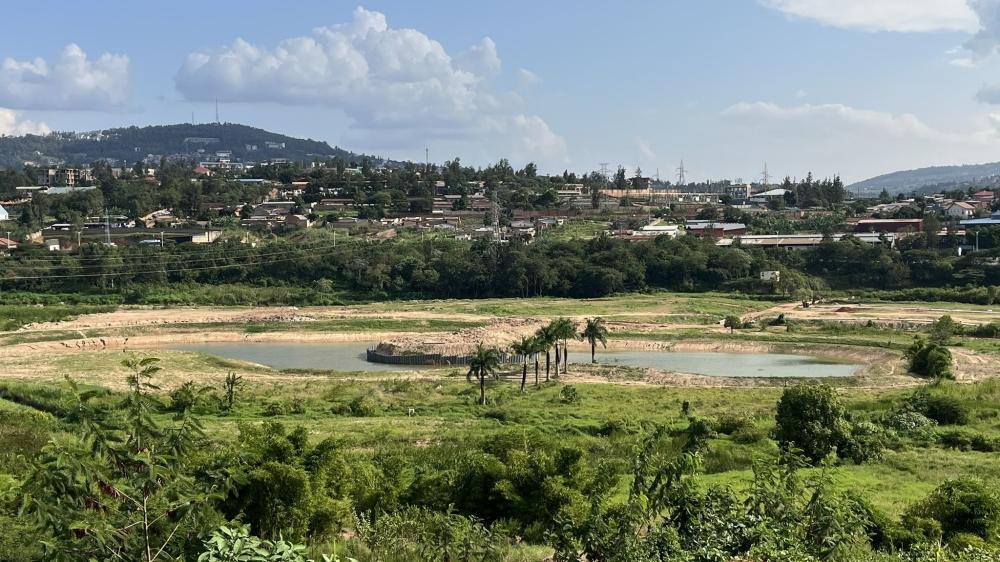Africa-Press – Rwanda. Five wetlands under rehabilitation in Kigali will have 58.5 kilometres of a circuit of pedestrian and cycling pathways to boost recreation and sports in the capital, according to Martine Uwera, the Programme Manager of Environmental Mainstreaming and Biodiversity Management at the Rwanda Environment Management Authority (REMA).
It is recommended that all pedestrian and cycling paths are flat and equipped with benches every 500 metres so that the entire site is easily accessible to all.
The rehabilitation works for the four wetlands—namely Kibumba (68 ha), Nyabugogo (131 ha), Rugenge-Rwintare (65 ha), and Gikondo (162 ha)—are at 56 per cent, while Rwampara (65 ha) rehabilitation is around 20 per cent since works started late, she explained.
Rwampara wetland is in the north of the four wetlands under the project and connects to Gikondo wetland. Gikondo wetland is located between Remera, Kimihurura and Kicukiro District.
Gikondo wetland connects to Rugenge-Rwintare wetland, which is between Kacyiru Sector and Muhima Sector at a place dubbed Poids Lourds.
Rugenge-Rwintare connects to Nyabugogo wetland and Kibumba wetland around the former Utexrwa and Red Cross premises, between Kinyinya, Gisozi and Kacyiru sectors.
Nyabugogo wetland starts from the Kinamba area and is located between Gatsata, Muhima and Gisozi sectors.
“All the five wetlands, covering 500 hectares, touch 10 sectors. The wetlands, after rehabilitation, will change the face of Kigali. They will help reduce floods, improve the quality of water, restore biodiversity, and serve as recreational spaces. That is why we will have 58.5 km of walkways and cycling paths to boost recreation and sports,” she said.
The rehabilitation of these degraded wetlands could directly and indirectly benefit 220,500 people in flood-prone areas and at risk of water crises, given that wetland degradation and pollution have significantly affected water quality and quantity.
“We are also rehabilitating drainages or ravines which could be flooded and inundate different areas including the Nyabugogo area,” Uwera said.
The project started in 2021 with designs, while construction works began in March 2024.
“We plan to complete the works by December 2025.”
Initially, a study showed that there is a need for $82 million for the whole project implementation. However, she said, $36 million has been mobilised for the first phase.
“The second phase is for private investment to be mobilised,” she added.
Proposed activities in the area also include a visitors’ centre, built from sustainable materials, situated at the entrance to the wetlands to provide information on wetland habitats and their conservation to raise awareness and draw the public.
Observation decks for watching wildlife and photography will be installed near ponds and riversides.
Proposed activities include light poles to ensure safety, sports grounds (football, volleyball, basketball), outdoor gym circuits, active play areas for children, and economic activities such as bike rental kiosks, food kiosks, event areas, craft and souvenir kiosks, rental of sports grounds, food courts/snack areas, landscaped areas with benches, greenery, water ponds, and a cultural events amphitheatre, among others.
Developers will also create small lakes in some of these wetlands.
Nyabugogo wetland will have facilities to curb floods affecting infrastructure such as roads, creation of a lake and a waterfront to improve the city’s landscape, and recreation of the natural profile of the river downstream.
Under the Kigali City Wetland Master Plan, 3,888 hectares are reserved for conservation. A further 3,851 hectares of wetlands are designated for sustainable use, and the remaining 1,421 hectares are set aside for tourism and recreation.
For More News And Analysis About Rwanda Follow Africa-Press






